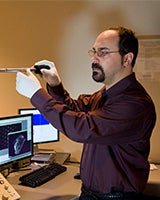The grant was established by the Osher Institute Advisory Board five years ago as a way to support Boise State faculty and help raise awareness of the Osher Institute within the university. Annual member contributions to Osher’s Excellence Fund make the grant possible.
The 2016 recipients are:
Cheryl Jorcyk, Biological Sciences

Cheryl Jorcyk
Breast cancer is the most commonly diagnosed cancer in women worldwide. Despite new drugs and improved screening and detection methods, the survival rate for breast cancer patients with tumors that have spread (metastasized) to other parts of the body remains a dismal 23 percent. This is in large part due to a critical lack of diagnostic tests for the early detection of patients with metastatic disease. The objective of Jorcyk’s Osher grant is to complete investigations addressing whether inflammatory protein levels are elevated in the serum of breast cancer patients with metastatic breast cancer and could act as biomarkers for identifying patients with metastatic disease.

Rick Ubic, Materials Science and Engineering
Sunlight on Earth provides more than 9,000 times more power than the global demand, but electricity from photovoltaic solar cells must compete with fossil fuel pricing if it is to capture a substantial portion of the global electricity markets. In order for a solar cell to be useful, it must efficiently convert sunlight to electrical current. In order to be viable, it must be inexpensive (compared to the alternatives). Recent advances in hybrid organic-inorganic ceramics have shown lead halide perovskites like (CH3NH3)PbI3 to be promising candidates for thin-film photovoltaics, allowing low-cost synthesis of solar cells. For this reason, the objective of the project will be to develop and refine a processing methodology for the reliable synthesis of perovskite photovoltaics devices based on (CH3NH3)SnI3.Rick Ubic, Materials Science and Engineering

Peter Mullner
Peter Mullner, Materials Science and Engineering
This project is centered around magnetic shape memory alloys, which shape-shift in response to magnetic fields. Apply a magnetic field, and the material changes shape. Remove it, and the new shape remains. Apply a different magnetic field and the material re-forms into a new shape. Do this quickly and with purpose and you have a motor or pump or any other device. The goal of this project is to use magnetic shape memory technology to modify an existing single crystal growth apparatus with a mechanism that decouples the drive system from the growth unit.

Cynthia Curl
Cynthia Curl, Community and Environmental Health
We know that maternal exposure to agricultural pesticides during pregnancy has been associated with subsequent decrements in cognitive, behavioral and neurological outcomes in children, including lower IQ, poorer memory, and increased incidence of attention deficit/hyperactivity disorder. However, it is not known whether the amount of pesticide exposure resulting from a conventional diet is substantial enough to cause these decrements, and whether any such effects could be prevented with an organic diet. Curl’s lab is conducting a pilot-scale dietary intervention study, in which women will be randomly assigned to eat either organic or conventional fruits and vegetables throughout their pregnancies, provided by the research team, who will repeatedly assess biological levels of pesticide metabolites in urine samples collected from study participants.
Grant recipients are encouraged to give a presentation for the Osher Institute about their research or scholarly projects, which adds to Osher programming.